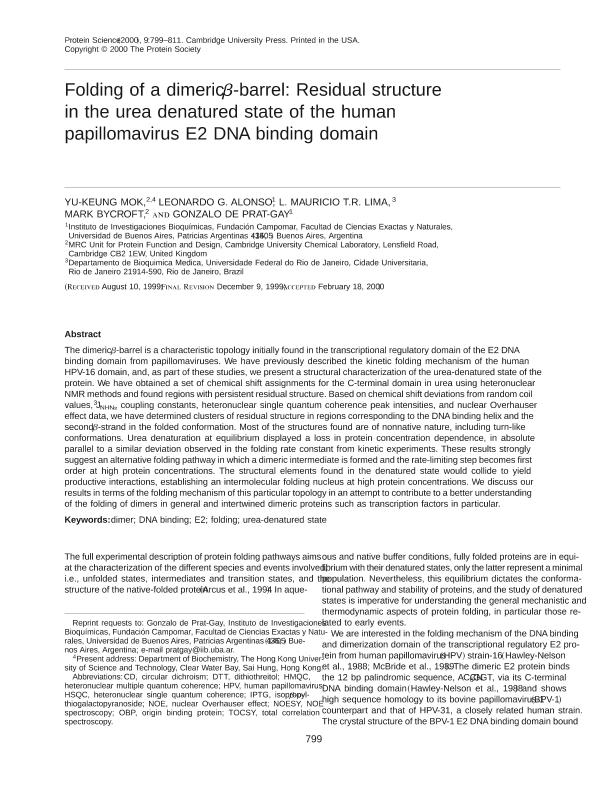Artículo
Folding of a dimeric β-barrel: Residual structure in the urea denatured state of the human papillomavirus E2 DNA binding domain
Mok, Yu Keung; Alonso, Leonardo Gabriel ; Lima, L. Mauricio T.R.; Bycroft, Mark; de Prat Gay, Gonzalo
; Lima, L. Mauricio T.R.; Bycroft, Mark; de Prat Gay, Gonzalo
 ; Lima, L. Mauricio T.R.; Bycroft, Mark; de Prat Gay, Gonzalo
; Lima, L. Mauricio T.R.; Bycroft, Mark; de Prat Gay, Gonzalo
Fecha de publicación:
04/2000
Editorial:
Cambridge University Press
Revista:
Protein Science
ISSN:
0961-8368
e-ISSN:
1469-896X
Idioma:
Inglés
Tipo de recurso:
Artículo publicado
Clasificación temática:
Resumen
The dimeric beta-barrel is a characteristic topology initially found in the transcriptional regulatory domain of the E2 DNA binding domain from papillomaviruses. We have previously described the kinetic folding mechanism of the human HPV-16 domain, and, as part of these studies, we present a structural characterization of the urea-denatured state of the protein. We have obtained a set of chemical shift assignments for the C-terminal domain in urea using heteronuclear NMR methods and found regions with persistent residual structure. Based on chemical shift deviations from random coil values, 3'J(NHN alpha) coupling constants, heteronuclear single quantum coherence peak intensities, and nuclear Overhauser effect data, we have determined clusters of residual structure in regions corresponding to the DNA binding helix and the second beta-strand in the folded conformation. Most of the structures found are of nonnative nature, including turn-like conformations. Urea denaturation at equilibrium displayed a loss in protein concentration dependence, in absolute parallel to a similar deviation observed in the folding rate constant from kinetic experiments. These results strongly suggest an alternative folding pathway in which a dimeric intermediate is formed and the rate-limiting step becomes first order at high protein concentrations. The structural elements found in the denatured state would collide to yield productive interactions, establishing an intermolecular folding nucleus at high protein concentrations. We discuss our results in terms of the folding mechanism of this particular topology in an attempt to contribute to a better understanding of the folding of dimers in general and intertwined dimeric proteins such as transcription factors in particular.
Palabras clave:
Folding Protein
,
Proteins
,
Human Papillomavirus
Archivos asociados
Licencia
Identificadores
Colecciones
Articulos(IIBBA)
Articulos de INST.DE INVEST.BIOQUIMICAS DE BS.AS(I)
Articulos de INST.DE INVEST.BIOQUIMICAS DE BS.AS(I)
Citación
Mok, Yu Keung; Alonso, Leonardo Gabriel; Lima, L. Mauricio T.R.; Bycroft, Mark; de Prat Gay, Gonzalo; Folding of a dimeric β-barrel: Residual structure in the urea denatured state of the human papillomavirus E2 DNA binding domain; Cambridge University Press; Protein Science; 9; 4; 4-2000; 799-811
Compartir
Altmétricas



